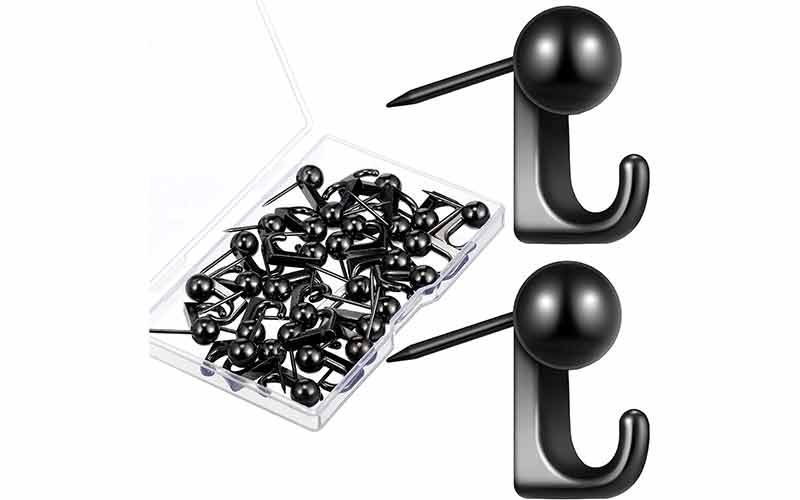Hanging & Installation
How to Hang Metal Wall Art (With or Without Nails, Hooks, Drilling) Guide
Metal wall art can transform a dull indoor or outdoor space into a stunning focal point. But hanging it securely and stylishly can be challenging, especially if you’re unsure where to start.
To hang metal art, first, prepare your wall surface, drill into your wall, then hang your metal art piece using nails, screws, or bolts. Without nails or hooks, you can use command/velcro strips, wire hanging systems, magnets, or adhesive hooks; no drilling!
With the right tools and hanging hardware suitable for your wall material and art pieces, you can securely mount metallic wall decor easily with minimal damage. This guide provides clear instructions on hanging different metal wall art pieces on different wall types. Also, find safety tips, common mistakes, and FAQs
Preparing Your Metal Art & Wall Surface
Getting ready to hang metal wall art takes some prep work. You must pick the right spot and ensure your wall can handle the piece.
Choosing the Right Location
Picking the perfect spot for your metal masterpiece is crucial. Here’s what to keep in mind:
- Room layout: Consider the flow of the room. You don’t want your art to be a stumbling block!
- Wall space: Make enough room for your piece to breathe.
- Lighting: Good lighting can make your art pop. Natural light is great but consider accent lighting too.
- Existing decor: Your new art should play nicely with what’s already there.
Pro tip: Stand back and imagine your art in different spots. Sometimes, the unexpected placement works best!
Further Reading: How to Choose the Right Metal Wall Art Pieces for Your Space and Style
Wall Surface Assessment & Protection
Identify your wall type—drywall, concrete, brick, plaster, or wood. Each surface requires a different approach for secure hanging. Check for hidden obstacles. Use a stud finder to locate wooden beams and electrical wires, marking their positions with masking tape.
Before you start drilling, give your wall a good clean. A damp cloth usually does the trick. For delicate surfaces, use a soft, dry brush. If needed, apply a protective layer to prevent damage.
This preparation ensures your art hangs securely and looks its best while keeping your wall pristine. A little care now saves headaches later!
Understanding Your Metal Wall Art
Size matters, and so does weight! Here’s what to check:
- Weight: This determines the type of hanger you’ll need. Heavy pieces need sturdy anchors and screws, while lighter art may only require picture hooks.
- Size affects the placement and hanging method. Large metal art demands more wall space and careful positioning, while smaller pieces offer flexibility in arrangement.
- Pre-installed hardware: Some art comes ready to hang. Lucky you!
Accurate weight and size assessment ensures you choose the right hardware. Check the manufacturer’s specifications or use a weighing scale to determine the piece’s weight and a tape measure the dimensions. Always factor in the art’s depth, especially for 3D pieces that protrude from the wall.
This info helps you pick the right hanging method and maintain proper clearance from furniture or walkways.
Gathering Essential Tools & Hanging Hardware
Proper tools are crucial for hanging metal wall art safely and accurately. Here’s a list of essential tools you’ll need:
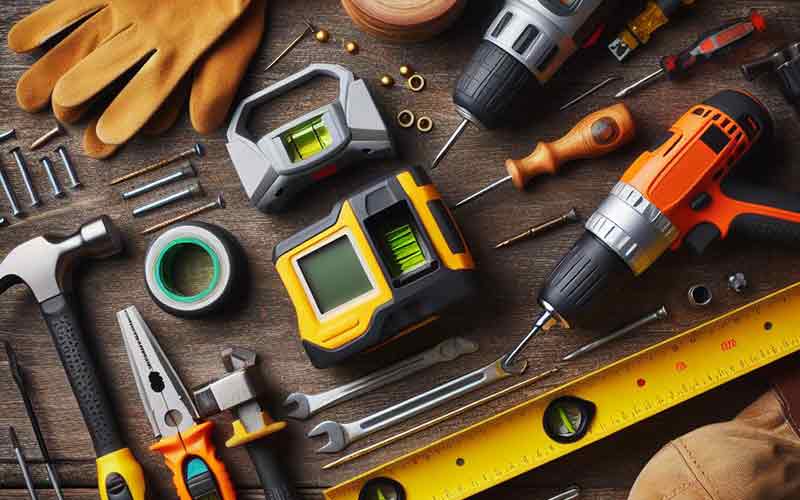
- Level: Ensures your artwork hangs straight and aligned.
- Power drill: Necessary for creating holes in walls, especially for heavier pieces.
- Screwdriver set: Useful for various screws and anchors.
- Stud finder: Helps locate wall studs for secure mounting.
- Tape measure: Accurately measures distances and placement.
- Pencil: Marks drill points and positioning on the wall.
- Masking tape: Useful for marking positions and protecting walls.
- Safety glasses: Protect your eyes during drilling.
- Dust sheet: Keeps your floor clean during installation
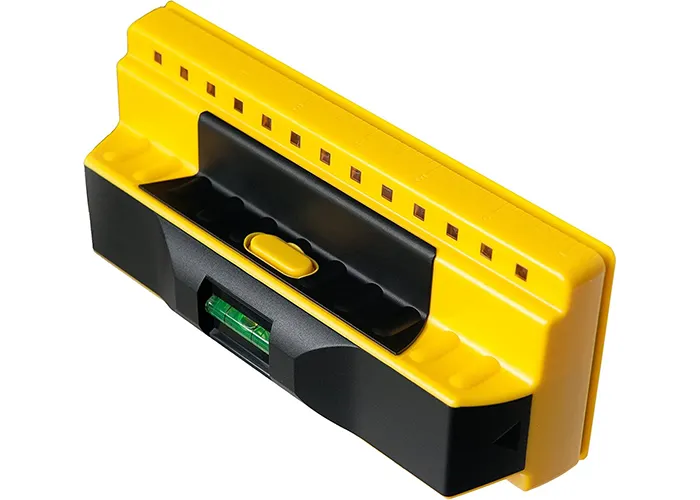
Choosing the proper hanging hardware is crucial for securely displaying metal wall art. Here’s a list of appropriate options to consider:
- Nails: Suitable for lighter metal art pieces.
- Screws and wall anchors: Ideal for heavier pieces on drywall. Use a stud finder to locate studs for extra support.
- Picture hooks: Suitable for lighter metal art. These come in various weight capacities.
- French cleats: Perfect for large, heavy metal pieces. They distribute weight evenly across the wall.
- Wire hanging systems: Versatile option for galleries or frequent rearrangement. Allows easy adjustments without damaging walls.
- Command/velcro strips: Great for temporary displays or renters.
- Masonry anchors: Essential for brick or concrete walls. Provide strong support for heavier metal art.
- J-hooks: Useful for hanging unframed metal pieces with pre-drilled holes.
- Sawtooth hangers are suitable for smaller, lighter metal art and are easy to install on the back of the piece.
- Keyhole hangers: Provide a flush mount for a sleek look that works well with flat metal art or prints.
- Toggle bolts: Offer superior support in hollow walls. Ideal for extra heavy metal sculptures.
- D-ring plates.
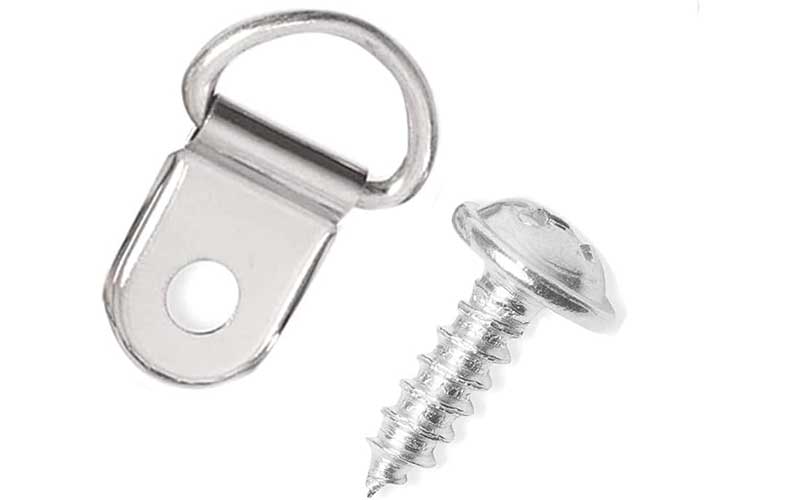
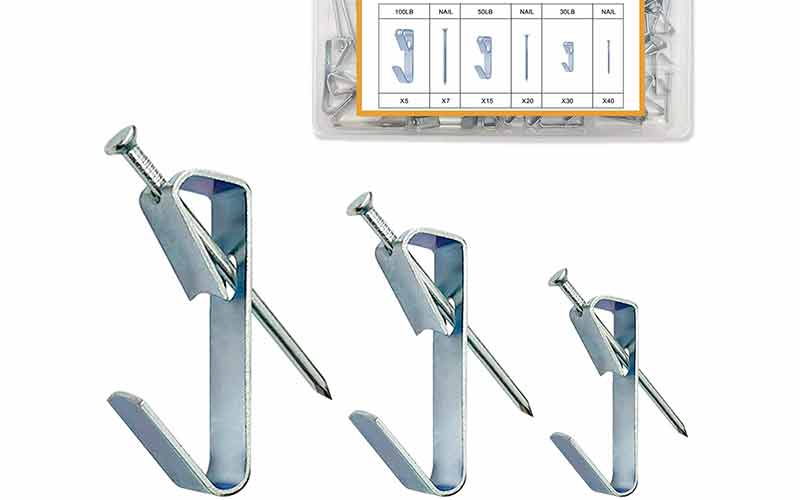
Hanging Metal Wall Art on Different Walls
Different walls need different hanging methods for metal art. Each surface type has its tricks for secure and safe installation.
How To Hang Metal Wall Art on Drywall
Drywall’s your friend. It’s easy to work with and forgiving but requires careful planning and the right tools. Follow these steps to mount your art piece on a drywall securely:
- Locate wall studs using a stud finder. Mark their positions with a pencil.
- Choose appropriate hanging hardware based on your art’s weight. Select anchors rated for at least 25% more than the artwork’s weight.
- Measure and mark the desired hanging spot on the wall. Use a level to ensure straight placement.
- If hanging on a stud, drill a pilot hole slightly smaller than your screw. Use screws 2.5 to 4.5 cm long to penetrate the stud.
- Install drywall anchors in areas between studs. Drill a hole, insert the anchor, and tap it flush with the wall surface.
- Attach hooks or hangers to your metal art if not pre-installed. Ensure they’re securely fastened.
- Hang the art piece on the installed hardware. Double-check its level and adjust if needed.
- For heavier pieces, consider using two hooks spaced apart for added stability.
- Clean any marks left by pencils or drilling with a damp cloth.
How To Hang Metal Wall Art on Brick Walls
Brick walls look great, but they can be challenging to work with. Follow these steps to display your metal artwork on brick surfaces securely:
- Clean the brick surface with a brush and mild detergent to remove dirt and debris.
- Measure and mark: Decide where you want your art.
- Select appropriate masonry drill bits for your drill, matching the size to your wall anchors.
- Drill pilot holes into the mortar joints between bricks, not the bricks themselves.
- Insert plastic masonry anchors into the drilled holes, tapping them gently with a hammer.
- Screw hooks or secure the hanger into the anchors.
- For heavier pieces, use brick clips that grip the edges of bricks without drilling.
- Carefully place your piece on the installed hooks or screws.
- Use a level to ensure your artwork is straight on the wall.
How to Attach Metal Art on Wood Wall
Wood walls offer a charming backdrop for metal art. Here’s how to hang your piece securely:
- Choose your hardware: Finishing nails work for lightweight pieces. For heavier art, opt for screws.
- Find the studs: While not always necessary, locating studs can provide extra support.
- Pre-drill holes: This step prevents the wood from splitting. Use a drill bit slightly smaller than your nail or screw.
- Hang with care: Drive the nail or screw into the pre-drilled hole. Don’t over-tighten screws – you might strip the wood.
- Level check: Use your trusty level to ensure your art hangs straight.
Pro tip: If you’re dealing with valuable or antique wood, consider using adhesive hangers to avoid damage.
Hanging on Plaster Walls
Plaster walls can be tricky. They’re prone to crumbling, so handle with care:
- Use plastic anchors: These distribute weight and prevent crumbling.
- Mark your spot: Decide where you want your art and make a small mark.
- Drill carefully: Use a masonry bit and drill slowly to avoid cracks.
- Insert the anchor: Gently tap it in with a hammer.
- Screw in the hanger: Use a screwdriver, not a drill, to avoid damaging the plaster.
- Hang and level: Place your art and check it’s straight.
Remember: Plaster walls may not support very heavy pieces. For weighty art, consider professional installation.
Concrete Walls
Concrete’s tough but not impossible. Here’s your game plan:
- Gather your tools: You’ll need a hammer drill, masonry bit, and concrete anchors.
- Mark and drill: Mark your spot and drill a hole slightly deeper than your anchor.
- Insert the anchor: Tap it gently until it’s flush with the wall.
- Screw in the hanger: Use a screw that fits your anchor.
- Hang your art: Carefully place your piece and check its level.
Tip: Concrete dust can be messy. Place a sheet below your work area for easy cleanup.
Tile Walls
Hanging on tile requires a delicate touch:
- Aim for grout lines: Whenever possible, drill into grout to avoid cracking tiles.
- Use tile-specific anchors: These are designed to grip without damaging the tile.
- Drill carefully: Use a tile drill bit and go slow to prevent chipping.
- Insert anchor and hang: Once the anchor’s in, screw in your hanger and hang your art.
Important: If you must drill into a tile, place masking tape over the spot first. This helps prevent the drill from slipping.
Stucco Walls
Stucco can be challenging but not impossible:
- Choose stucco-specific anchors: These are designed to grip the irregular surface.
- Mark your spot: Decide where you want your art.
- Drill a pilot hole: Use a masonry bit and drill slowly.
- Insert the anchor: Tap it in gently with a hammer.
- Screw in the hanger: Use a screw that fits your anchor.
- Hang and level: Place your art and ensure it’s straight.
Remember: Stucco can be brittle. Work carefully to avoid causing damage to the wall surface.
Always prioritize safety, no matter what type of wall you work with. If you’re unsure about the process or dealing with particularly heavy art, don’t hesitate to call in a professional. Your walls (and your art) will thank you!
How to Hang Metal Wall Art Without Nails or Hooks
Sometimes, you want to hang art without leaving drilling and nail marks. Whether you’re renting, have delicate walls, or prefer a non-permanent solution, here are some clever ways to display your metal wall art without nails or hooks.
Command Strips
These handy adhesive strips are a go-to for many art lovers who want their beautiful art without nails or screws. They adhere securely to the wall and the artwork, forming a strong connection.
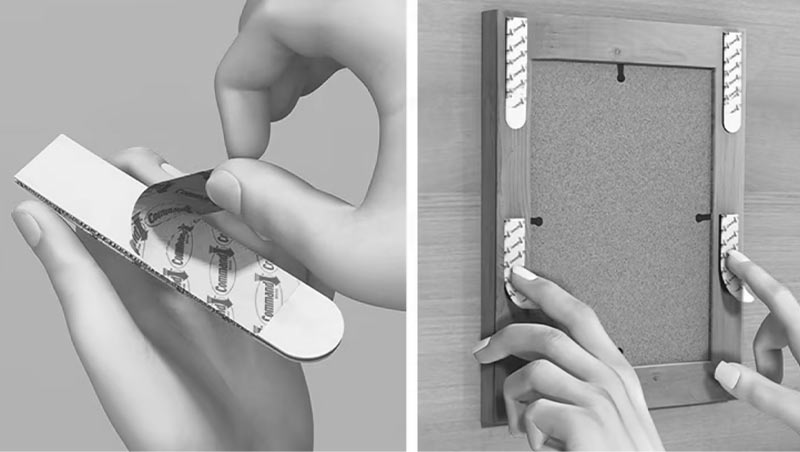
I’ve utilized Command Strips for years to hang lightweight metal prints and decorative items. They perform well on drywall, painted surfaces, and even tile. The main advantage? No holes in the wall when it’s time to change decor.
Here’s how to use them:
- Clean the wall: Use rubbing alcohol to remove any dirt or oils.
- Prepare the strips: Stick pairs together, then peel one side.
- Apply to your art: Stick the exposed adhesive to the back of your metal piece.
- Hang it up: Peel the other side and press firmly against the wall for 30 seconds.
Pro tip: Check the weight limit on the package. For heavier pieces, use multiple strips.
Velcro Strips
Similar to Command Strips, but with a bit more flexibility:
- Clean surfaces: Both the wall and the back of your art should be clean and dry.
- Cut to size: Measure and cut the Velcro to fit your art piece.
- Apply strips: Stick one side to your art, the other to the wall.
- Press together: Line up the strips and press firmly.
Bonus: Velcro allows for easy repositioning if you change your mind about placement.
Wire Hanging Systems
Wire hanging systems offer a more versatile solution for metal wall art, perfect for galleries or homes where you like to change up your art often. They allow you to adjust the height and position of your artwork without damaging walls.
These systems use thin cables or wires attached to wall-mounted tracks or rails. You can hang your metal pieces with invisible string or decorative rope, creating a unique display.
Wire systems work well with vintage picture rail moldings, adding a touch of elegance to your decor. Here are steps to use them:
- Install the track: Mount a horizontal track along the top of your wall.
- Hang the wires: Attach vertical wires to the track.
- Add hooks: Slide adjustable hooks onto the wires.
- Hang your art: Place your metal piece on the hooks and adjust as needed.
Magnetic Walls
If you’re lucky enough to have magnetic walls (or don’t mind creating one), this method is fun and flexible. High-powered magnets stick firmly to the wall, holding artwork securely without nails or hooks.
I’ve used magnetic walls in my home office to display metal prints. They make it simple to rearrange or swap out artwork whenever I want, and they avoid permanent marks on the walls. For heavier pieces, stronger magnets or additional support may be needed.
Steps:
- Check your wall: Make sure it’s magnetic. Some metal walls aren’t!
- Choose strong magnets: Neodymium magnets work well for most pieces.
- Attach magnets: Glue magnets to the back of your metal art if needed.
- Stick it up: Place your art on the wall. Magic!
Remember: This method works great for lightweight metal art. Test the strength of your magnets with the actual piece before letting go completely.
Adhesive Hooks
Adhesive hooks are another nail-free option for hanging metal art. They are great for hanging lighter metal art pieces or decorative items.
These handy devices offer a simple solution for renters or those hesitant to make holes in their walls. Adhesive hooks stick directly to wall surfaces using strong double-sided tape.
I’ve used these hooks in my apartment and found them easy to apply and remove. Here are the steps to use them properly
- Clean the wall: Use rubbing alcohol for best results.
- Remove the backing: Peel off the adhesive cover on the hook.
- Apply pressure: Press the hook firmly against the wall for about 30 seconds.
- Wait: Let the adhesive set for about an hour before hanging your art.
Tip: Some adhesive hooks can hold surprising amounts of weight. Always check the package for limits.
Leaning Art
Who says art always has to hang? For a casual, modern look:
- Find a surface: A mantel, shelf, or floor can work.
- Protect the wall: Use felt pads on the back of your metal art to prevent scratches.
- Lean and layer: Place larger pieces in the back and smaller ones in front for depth.
Safety first: Make sure your art is stable and won’t easily topple over.
Tension Rods
An unexpected but effective method:
- Measure your space: Find a spot where a tension rod will fit snugly.
- Install the rod: Place it below where you want your art to hang.
- Hang your art: Use S-hooks or wire to suspend your piece from the rod.
Bonus: This method works great for awkward spaces like between bookcases.
Remember, while these methods are generally safe for walls, always test in an inconspicuous area first. And for particularly valuable or heavy pieces, it might be worth consulting a professional.
With these creative hanging solutions, you can display your metal wall art without worrying about damage to your walls. Happy decorating!
Hanging Metal Art Outdoor Considerations
Outside metal art installation requires special attention to withstand the elements. Choose weather-resistant pieces and hanging kits made of stainless steel, aluminum, or treated iron to prevent rust and corrosion.
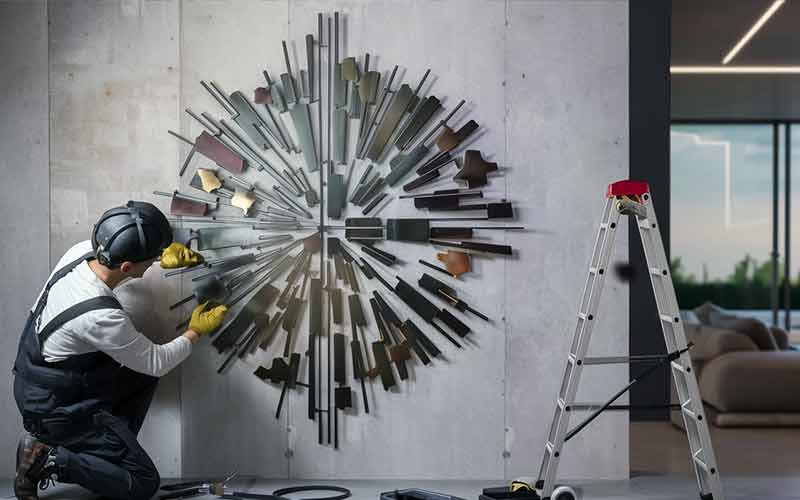
For secure mounting, 3M exterior command hooks support up to 2 kg and work well on smooth surfaces like vinyl siding. Brick Clips offer a non-invasive option for brick walls, while vinyl siding hooks provide a damage-free solution for exterior cladding.
Consider the artwork’s placement to protect it from direct sunlight, heavy rain, or strong winds. Leave a small gap so the metal can safely expand and contract with temperature swings.
Regular cleaning and maintenance will help preserve the metal’s finish and prevent dirt or debris buildup. To block moisture intrusion, apply a clear sealant over exposed metal areas. Inspect it regularly for weathering and re-seal or tighten as needed.
Tip: Mount your outdoor art on a robust vertical surface, such as a fence or wall, that can support the weight over time.
Metal Art Mounting Tips for Various Art Styles
Different metal art styles need specific mounting methods. Each type, from 3D pieces to flat prints, requires a unique approach for a secure and attractive display.
3d Metal Art
3D metal art adds depth and texture to your walls. These pieces often feature intricate designs that pop out from the surface. Hanging them requires special care. Use sturdy wall anchors or find studs to support the weight.
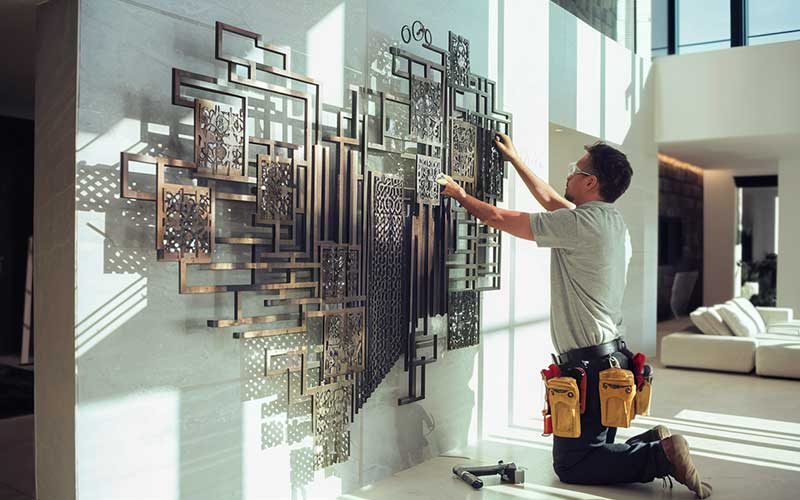
Multiple hanging points help distribute the load evenly. Determine the heaviest areas and plan your hanging points accordingly.
For larger 3D metal pieces, consider a French cleat system. This method provides extra stability and makes leveling easier.
Tip: Add spacers and standoff to prevent the sculpted sections from scraping or denting the wall.
Large or Heavy Metal Art
Large or heavy metal art pieces need extra care when hanging. They often exceed 25 pounds and require sturdy support. Use a stud finder to locate wall studs for secure mounting.
Anchor bolts provide added strength, especially for pieces weighing over 50 pounds. Always choose hangers rated for at least 25% more than your art’s weight.

For oversized metal sculptures, consider professional installation. They may need custom brackets or wall reinforcement.
Flat Metal Art(Pictures/Prints)
Moving from large pieces, flat metal art offers a sleek, modern look. These prints and pictures often have a smooth surface, perfect for minimalist decor. Hanging them requires precision and care.
For lightweight, flat metal art, double-sided tape can work well. Heavier pieces may need screws or anchors. A level ensures straight placement. Command strips offer a damage-free option for renters or those wary of wall holes.
Always check the weight limit of your chosen hanging method. Clean the wall surface before mounting to ensure good adhesion. Use a ruler to mark exact spots for multiple pieces in a gallery wall setup.
Framed and Unframed Metal Art
Framed and unframed metal art offer unique hanging challenges. Framed pieces often come with built-in hardware, making them easier to mount.
Unframed metal art may require special hangers or adhesive strips. Choose screws and anchors that match your wall type and the art’s weight. For heavier pieces, locate wall studs or use heavy-duty drywall anchors.
Post-Mounting Care and Maintenace
- Clean your metal art regularly with a soft cloth to maintain its shine.
- Avoid harsh chemicals that could damage the finish.
- Always check the artist’s care instructions before cleaning.
- Regular inspections and adjustments, especially for heavier pieces
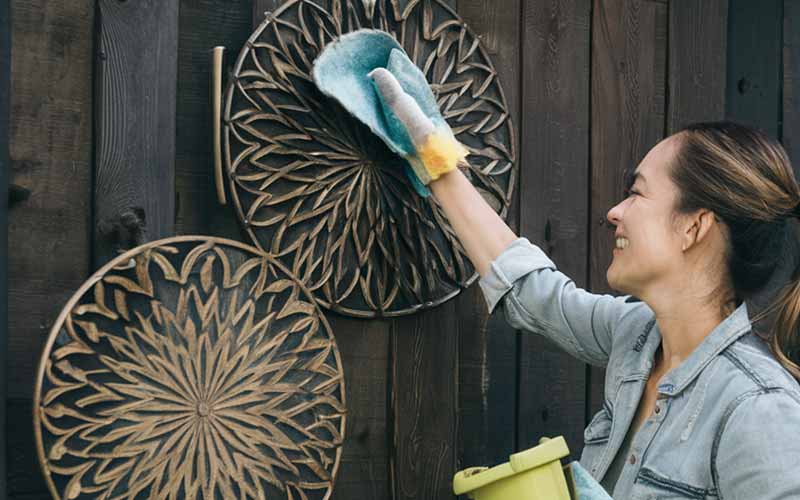
Further Reading: How to Clean and Maintain Your Metal Wall Art Pieces
Safety Considerations
Weight limits:
Different hanging methods have varying weight limits. Knowing these limits ensures safe and secure installation of your metal wall art. Here’s a quick guide to common hanging methods and their weight capacities:
| Hanging Method | Weight Limit |
|---|---|
| Command Strips | Up to 3.5 kg (7.7 lbs) |
| Plaster Hooks | Up to 13 kg (28.6 lbs) |
| Drywall Anchors | 5 to 34 kg (11 to 75 lbs) |
| Picture Hanging Wire | Up to 45 kg (100 lbs) |
| French Cleats | Up to 90 kg (200 lbs) |
Always check the weight of your metal art piece before choosing a hanging method. For heavier items, use multiple hangers or seek professional help.
More safety:
- Avoiding electrical wires and plumbing
- Ensuring stability and security
- Use proper step stools or ladders to access high pieces
- Don’t overreach or hang at extreme angles that could cause falls
- Consider having someone assist with large, heavy artwork or enlist the services of professionals
Common Mistakes to Avoid
- Overloading wall anchors
- Ignoring wall-type differences
- Skipping safety checks
Conclusion
Hanging metal wall art doesn’t have to be a headache. With the right tools, techniques, and patience, you can create a stunning display that’s safe and secure.
Remember, practice makes perfect. Don’t be afraid to start small and work up to bigger pieces. And most importantly, have fun with it!
FAQs
How do I hang metal letters/signs wall art?
For lightweight letters, use adhesive strips. For heavier ones, use individual wall anchors for each letter.
How can I hang metal wall art on siding?
Use vinyl siding hooks that slide into the seams of the siding without causing damage. For heavier pieces, install a sturdy hanger into a stud behind the siding
How do I hang wrought iron wall decor?
Locate a stud using a stud finder, then drill a pilot hole and secure a heavy-duty screw or anchor. Ensure the hardware can support the weight of the wrought iron piece
How high should I hang my metal wall art?
A common guideline is to hang artwork at eye level, approximately 57 to 60 inches from the floor to the center of the piece. Adjust based on your room’s furniture and ceiling height.
How often should I check the stability of my wall art?
It’s advisable to check the stability of your wall art every few months, especially if it’s in a high-traffic area or subject to vibrations from nearby activities
Further Reading


